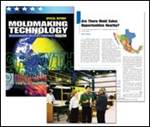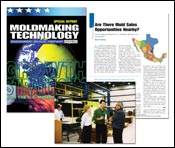Ten Years of Change and Challenge in the Moldmaking Industry
The changes and challenges that AMBA members have seen over the past 10 years have required them to be flexible and meet these changes and challenges head on.
A decade in the mold manufacturing industry is a long time. Looking back to 2000, the American Mold Builders Association reached the pinnacle of its membership at about 440 member companies. It seemed then that there could be no stopping the expansion of U.S. manufacturing. As molding companies added equipment to meet the ever-increasing demand of its OEM customers for more and more products, mold manufacturers also expanded to meet demand from both its OEM and molder customers. While it was not apparent then, it soon became starkly clear that all this added capacity would come back to haunt the industry.
The AMBA celebrated its 29th year as a trade organization in 2002, and that was also the year that a shift began in U.S. mold manufacturing. The fallout from overly high inventories of OEMs began impacting molders in 2001 as orders for parts and assemblies fell. By 2002 moldmakers were feeling the pinch of these attempts by OEMs to reduce inventory. The rush to take more and more product manufacturing offshore was becoming a reality for many. Capacity in molding and moldmaking suddenly became a problem.
From 2002 onward, membership in the AMBA began dropping with many members with long and storied histories in the industry closing their doors, unable or in some cases, unwilling to contend with the global competitive issues. Auctions became commonplace, and continue today albeit at a much slower pace.
Challenges and Changes
In spite of the downturn, many AMBA member companies found ways to survive and even thrive in this atmosphere. Reduced capacity gave those who remained in business greater opportunities for adding new business. A number of AMBA member companies have expanded their capabilities, opened satellite companies, began exporting molds, and found new ways to add value to their business to attract new customers.
Automation
The changes and challenges that our members have seen over the past 10 years have required them to be flexible and meet these changes and challenges head on. For the most part, they’ve been successful. Scott Harris, President of Harris Precision Mold (Tempe, AZ) and past President of the AMBA, offers his take on some the changes he’s seen over the past decade. “Automation—robotics—is a huge change that we didn’t have 10 years ago,” Harris says. “The technology transformation from that of artisan or craftsmanship of our business to high-tech machinery, processes and procedures that drive our business has had a huge impact on our operations.”
Donna Pursell, CEO of Prestige Mold Inc. (Rancho Cucamonga, CA) and member of the AMBA Board of Directors, agrees. “Ten years ago we didn’t have any automation to speak of,” she says. “Over the past decade we made increasingly larger investments in automation, robotics and manufacturing cells to meet demand for faster leadtimes and higher quality molds.”
Pursell adds that automation and robotics in the mold shop has been the biggest change for Prestige. “The advent of automation and robotics technology has changed the way that moldmakers work today—in specialized departments rather than one guy running the job—and has had a huge impact on the way we run our business today compared to 10 years ago,” she says.
Pete Manship, President of Mold Craft Inc. (Willernie, MN) and former President of the AMBA, also credits the move to more automation and CNC equipment with changing the way mold shops operate. “It’s a huge investment,” explains Manship, “but I think it’s not an optional investment. This capital equipment is far too much of an investment to let it sit idle, which means we need three manned shifts during the week, pick up hours on the weekend and fill the cracks with automation. Toolmakers are really embracing automation and striving to make better utilization of it.”
Workforce Issues
Which brings up another issue for mold shops today. “Employment is and will continue to be a huge challenge,” points out Harris. Manship concurs. “Finding good people and attracting our youth to the industry is a big issue. We’re working with the AMBA in Minnesota on this. With our new career path brochure, we are trying to educate people in the eighth grade that there’s something more for them than a liberal arts degree; that they can get a good technical degree and can make a good living in this trade.”
Harris isn’t so optimistic about the availability of skilled workers. “I would say the new people coming into the trade are definitely different, and while 10 years ago, training was very robust and there was a lot of interest and eagerness of those coming in, I don’t see us meeting the number of people we need,” he continues. “I’m afraid our industry is in for a rude awakening with the lack of people coming into the trade.”
Expansions/Growth
In spite of the challenges, there are successes among member companies. Harris is just one of several that expanded with a satellite facility, opening a shop in Salt Lake City, UT, to serve customers there. However, even that has new challenges.
“The difference in the ability to start a shop today versus 10 years ago is that then you could still start a shop pretty easily,” explains Harris. “Today so much more is needed. I couldn’t have started the Salt Lake facility without a beachhead company to support it. I couldn’t do 10 years ago what I did this year in Salt Lake City. Today it’s hard to start a shop from scratch.”
Globalization’s Effect on Leadtimes
Almost all members agree that the global economy has been the greatest change and will continue to present challenges and opportunities. Moldmakers are pressured in costs, but in leadtimes as well. “Certainly leadtimes have been reduced significantly, but that’s not a bad thing,” notes Harris. “Ten years ago there was no real major threat of foreign competition, and now it’s something we run into a lot.”
Tomorrow’s Moldmaker
Today’s moldmaker is asked to do so much more than 10 years ago. “Ten years ago the moldmaker built the mold to fit, form and function, and his job was to get it done and get it out,” says Harris. “Today, customers are involving us in product design, CPK, PPAP, qualifying the mold,” Harris says. “We’re being asked to do more, but getting less and less money for it. We’re doing much more value added, but prices are still being squeezed, which means we need to capture that value from other areas.”
Related Content
Editorial Guidelines: Editorial Advisory Board
The Editorial Advisory Board of MoldMaking Technology is made up of authorities with expertise within their respective business, industry, technology and profession. Their role is to advise on timely issues, trends, advances in the field, offer editorial thought and direction, review and comment on specific articles and generally act as a sounding board and a conscience for the publication.
Read MoreThink Safety: Eliminate Hazards Throughout the Shop
The tooling community is taking advantage of new products for safer mold shops and molding facilities.
Read MoreOEE Monitoring System Addresses Root Cause of Machine Downtime
Unique sensor and patent-pending algorithm of the Amper machine analytics system measures current draw to quickly and inexpensively inform manufacturers which machines are down and why.
Read MoreTackling a Mold Designer Shortage
Survey findings reveal a shortage of skilled mold designers and engineers in the moldmaking community, calling for intervention through educational programs and exploration of training alternatives while seeking input from those who have addressed the issue successfully.
Read MoreRead Next
Looking Back and Planning Forward
A review of a decade of global challenges and change.
Read MoreReasons to Use Fiber Lasers for Mold Cleaning
Fiber lasers offer a simplicity, speed, control and portability, minimizing mold cleaning risks.
Read MoreHow to Use Continuing Education to Remain Competitive in Moldmaking
Continued training helps moldmakers make tooling decisions and properly use the latest cutting tool to efficiently machine high-quality molds.
Read More



















